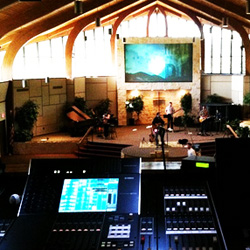
Phase 1:
Add a DSP box between the output of the mixer and the feeds to the main speakers and on-stage monitors.
Features added could be:
• Parametric wide-band equalization. This alone would greatly improve this system.
• Parametric narrow-band equalization. A short RT60 makes this unnecessary at this time. However, remodeling could increase RT60 to where narrow-band equalization would be needed. (This room could use bass absorbers).
• High-pass filtering. If not in the 24-channel mixer already.
• Compression. Always a good idea with microphones because of the inverse square law relationship between the preacher’s mouth and the location of the microphone.
• Feedback suppression. If needed.
Phase 2:
Automation is incorporated with automixers and remote controls. There are many exciting ways to add these features depending on the needs of individual congregations.
The most obvious upgrade would be to add the ability for a minister to turn on and control the main microphones from a simple control panel located in easy reach at the front of the room.
Phase 3:
The very uneven coverage of the congregation by the stereo loudspeaker pair needs to be addressed, as shown in Figure 12. The seats directly in front of the speakers have enough level to kill small animals.
If the audio system were perfect then each seat in the congregation would have the same audio level. In the author’s experience, similar rooms have been controlled within a couple of dB.
In this example, the seat closest to each loudspeaker is about 15 dB louder then the worst seat on the floor, and interference between the two speakers adds to a very lumpy and unpleasant frequency response.
Another problem is that the FOH (front of house) mixer is placed in a location for good sound, causing the levels at the ends of the front rows to be way too loud.
